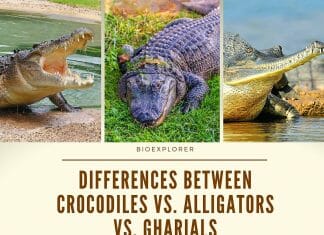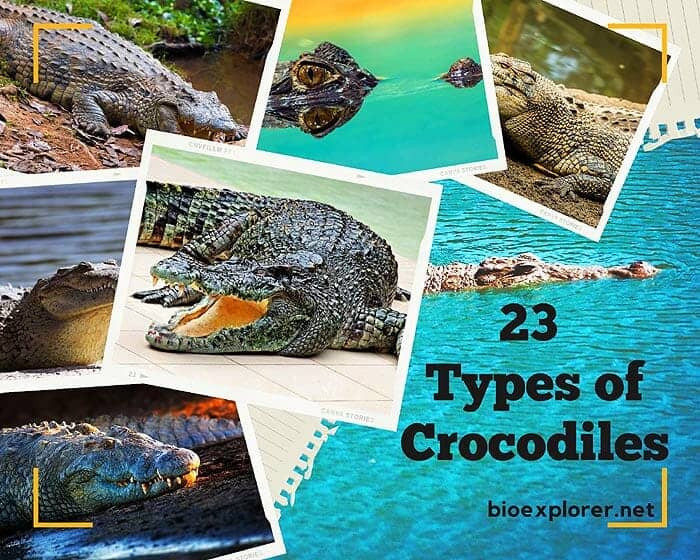
Crocodiles belong to the reptile family, which also includes snakes, turtles, and lizards. They live in swamps, rivers, marshes, and other warm water areas. Crocodiles have been here on earth for about 240 million years, appeared at least 25 million years before the first dinosaurs and 100 million years before the birds and mammals came into existence.
Crocodilia is one of the reptile orders dedicated to large, lizard-shaped, and predatory reptiles, including crocodiles, gharials, alligators, and caimans.
Crocodile Word Origin
Differences Between Crocodiles, Alligators & Gharials
Differences Between Crocodiles and Alligators and Gharials
Types of Crocodiles
Currently there are 23 different types of crocodile species have been identified and classified in the reptile order – Crocodilia.
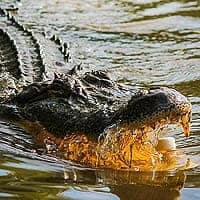
American alligator (Alligator mississippiensis)
Animalia Crocodilia Alligatoridae Alligator Alligator mississippiensis The American alligator is a giant crocodilian reptile endemic to the Southeastern United States. Living in the bodies of freshwater, the American alligator is slightly larger than the Chinese alligator. The other names to American alligators are gators and common alligators. These apex predators feed on fish, amphibians, other reptiles, birds, and mammals.
The taxonomy classification for the American alligator was done by François Marie Daudin (French Zoologist) in 1802.
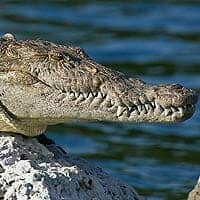
American Crocodile (Crocodylus acutus)
Animalia Crocodilia Crocodylidae Crocodylus Crocodylus acutus The American crocodile is one of the most widespread crocodile species in the Americas (North and South). These crocodiles have a tolerance to saltwater due to salt glands under their tongue. As a result, they thrive in saltwater swamps, lagoons, islets, lays, and small islands. Weighing up to 2000 lbs, American crocodiles are dangerous to humans.
In 1807, Georges Cuvier, a French naturalist has added the American crocodile to the binomial classification.
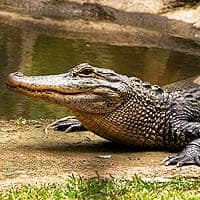
Australian Freshwater Crocodile (Crocodylus johnsoni)
Animalia Crocodilia Crocodylidae Crocodylus Crocodylus johnsoni The Australian Freshwater Crocodile is also known as Johnstone’s crocodile or freshie. These freshies are endemic to the northern region of the Australian continent. Diet-wise these freshwater crocodiles do not prefer humans, so not-man-eaters; however, they can deliver a nasty bite in self-defense if within their vicinity. Being saltwater tolerant, they dine on fish, birds, bats, reptiles, and mammals.
Gerard Krefft, an Australian zoologist, named this species in 1873.
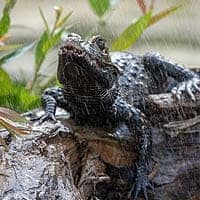
Black Caiman (Melanosuchus niger)
Animalia Crocodilia Alligatoridae Melanosuchus Melanosuchus niger The black caiman is another enormous crocodile, along with the American crocodile growing up to 20 feet in length. This carnivorous reptile prefers to habitat on the slow-moving rivers, lakes, Amazon basin, and other freshwater habitats of South America. Juveniles start with white and yellow pale banding on the flanks, and it turns into almost black as an adult, hence the name. Black caimans have a generalist diet as apex predators and can take virtually any terrestrial and riparian animals in their territory. Sometimes, they cannibalize juveniles of their own kind.
Johann Baptist von Spix was a German biologist who classified the black caiman as one of the crocodile species in 1825.
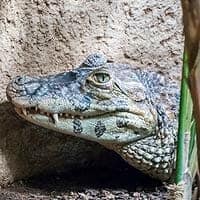
Broad-snouted Caiman (Caiman latirostris)
Animalia Crocodilia Alligatoridae Caiman Caiman latirostris The Broad-snouted caiman is mainly seen in eastern and central South American countries, including southeastern Brazil, northern Argentina, Uruguay, Paraguay, and Bolivia. These freshwater crocodiles are usually in still or very slow-moving waters. It feeds primarily on small invertebrates, turtles, and snails.
François Marie Daudin, a French naturalist, added the Broad-snouted caiman to the binomial classification in 1802 as a crocodile species.
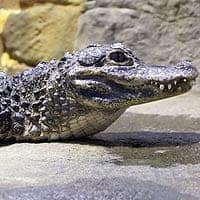
Chinese Alligator (Alligator sinensis)
Animalia Crocodilia Alligatoridae Alligator Alligator sinensis The Chinese alligators are also known as the Yangtze alligator or the muddy dragon, and they are endemic to China. Inhabiting freshwater, the Chinese alligator’s range is restricted to 6 regions in the province of Anhui and possibly the provinces of Jiangsu and Zhejiang. These carnivorous opportunistic feeders prey on a variety of different animals depending on what is available.
In 1879, Albert-Auguste Fauvel, a French naturalist, has classified the Chinese alligator as a valid species into the Crocodilia reptile order.
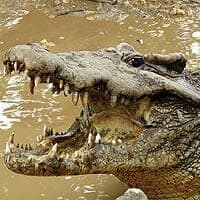
Cuban Crocodile (Crocodylus rhombifer)
Animalia Crocodilia Crocodylidae Crocodylus Crocodylus rhombifer The Cuban crocodile is one of the small-medium species and endemic to Cuba. Highly aggressive despite its modest stature, it is dangerous to humans on their territories. They prefer freshwater swamps, rivers, and marshes. Feeds on fish, turtles, and mammals tend to perform cooperative hunting as a pack to take down the prey. These crocs are super intelligent animals with developed cerebral cortex where in captive environments, they can be taught tricks and suggesting intelligence. The Cuban crocodiles are listed as Critically Endangered (CE) by IUCN due to extreme hunting by humans.
The world-famous French naturalist, Georges Cuvier, took the honors to name this crocodile species into taxonomy in 1807.
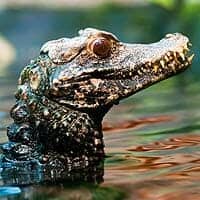
Cuvier's Dwarf Caiman (Paleosuchus palpebrosus)
Animalia Crocodilia Alligatoridae Paleosuchus Paleosuchus palpebrosus Cuvier’s dwarf caiman is one of the smallest crocodiles distributed in northern and central South America, including Bolivia, Brazil, Columbia, Ecuador, and Venezuela. It habitats in riverine forests, flooded forests near lakes, and fast-flowing rivers and streams. The musky caiman, the dwarf caiman, and the smooth-fronted caiman are the common names of this freshwater croc. Due to its small size (up to 4 feet long), this crocodile is kept in captivity as a pet. They feed on invertebrates, fish, amphibians, and mollusks.
Georges Cuvier, a French naturalist, named this crocodile species after his name in 1807.
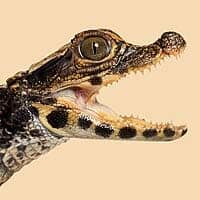
Dwarf Crocodile (Osteolaemus tetraspis)
Animalia Crocodilia Crocodylidae Osteolaemus Osteolaemus tetraspis The dwarf crocodile is an African crocodile, and it is the smallest living freshwater crocodile species. The African dwarf crocodile and bony crocodile are other common names for this crocodile species. The dwarf crocodile is mainly nocturnal and timid; they hide in the pools or borrows during the daytime. Dwarf crocs tend to feed on fish, crabs, frogs, insects, lizards, water birds, bats, and more as generalist predators. Dwarf crocodiles can be spotted in tropical regions of Sub-Sharan West Africa and Central Africa countries, including Senegal and Uganda.
An American herpetologist, Edward Drinker Cope, took the honors in naming this crocodile in 1861.
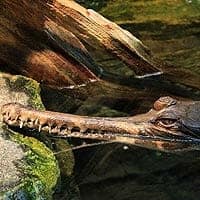
False Gharial or Malayan Gharial (Tomistoma schlegelii)
Animalia Crocodilia Gavialidae Tomistoma Tomistoma schlegelii The Malayan Gharial is also called the False Gharial and the Sunda Gharial, habitats freshwater bodies. It is endemic to the Peninsular Malaysia, Sumatra, Borneo, and Java islands. Currently, it is listed as Vulnerable by ICUN due to the drainage of its freshwater swamplands and clearance of surrounding rainforests. This crocodile has not been studied in detail until recent times. The false Gharial has a generalist diet and preys on fish, cows, small aquatic animals, proboscis monkeys, deer, water birds, and other reptiles.
The taxonomy classification for the False Gharial was done by Salomon Müller, a German naturalist, in 1838.
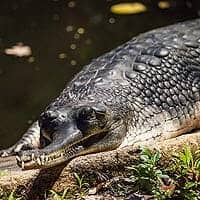
Gharial (Gavialis gangeticus)
Animalia Crocodilia Gavialidae Gavialis Gavialis gangeticus The Gharial is the fish-eating crocodile from the northern Indian subcontinent, including India, Nepal, Bhutan, and Myanmar. This longest freshwater crocodile is about 20 feet in length. The name Gharial comes from the Indian word Ghara, an earthenware pot to store water resembles the boss at the end of the snout. Unfortunately, the wild gharial population has faded drastically due to loss of habitats from sand mining and depletion of fish resources. As a result, the IUCN upgraded its status to Critically Endangered (CE) in 2007.
A German naturalist, Johann Friedrich Gmelin, had classified the Gharial into taxonomy in 1789.
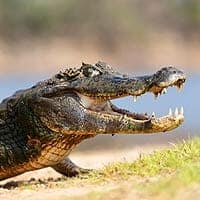
Jacare Caiman (Caiman yacare)
Animalia Crocodilia Alligatoridae Caiman Caiman yacare The yacare caiman is found in South American countries like Brazil, Argentina, Bolivia, and Paraguay. These freshwater amphibians inhabit the rivers, swamps, and lakes. They are solitary animals but are often seen in groups because they are matrilineal dominant – this means females dominate over males. The other names are jacare caiman, Spanish yacaré, Paraguayan caiman, piranha caiman, red caiman, and southern spectacled caiman.
The French naturalist, François Marie Daudin, added Jacare caiman as another crocodile species into the taxonomy in 1802.
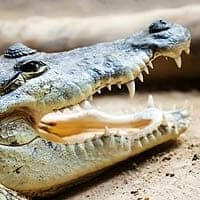
Morelet's crocodile (Crocodylus moreletii)
Animalia Crocodilia Crocodylidae Crocodylus Crocodylus moreletii Morelet’s crocodile is also called the Mexican crocodile. These freshwater crocodiles are primarily found in the Atlantic regions of Mexico, Belize, and Guatemala. Highly opportunistic, these Mexican crocs eat anything that comes into their territories, including small mammals (tapirs, goats, dogs, and cats), birds, other reptiles, and crustaceans. Sometimes they are cannibalistic towards their species.
Gabriel Bibron and André Marie Constant Duméril, two French zoologists, took honors in naming Morelet’s crocodile into taxonomy in 1851.
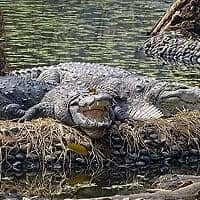
Mugger crocodile (Crocodylus palustris)
Animalia Crocodilia Crocodylidae Crocodylus Crocodylus palustris The Mugger Crocodile got its name from Indian mythology, where crocodile-like animal called ‘Magara‘. So the names Mugger and Magar are interchangeably used to denote this Indian sub-continent freshwater medium-sized crocodile. These ‘Vulnerable IUCN status’ crocodiles prey on insects, snakes, monkeys, squirrels, rodents, fish, reptiles, birds, mammals, and dead animals in dry seasons. Currently, they are protected by laws in Iran, India, and Sri Lanka.
A French herpetologist, René Lesson, classified the mugger crocodile into the taxonomy in 1831.
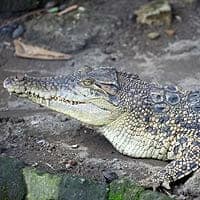
New Guinea crocodile (Crocodylus novaeguineae)
Animalia Crocodilia Crocodylidae Crocodylus Crocodylus novaeguineae The New Guinea Crocodile is one of the small crocodile species primarily found in the northern part of New Guinea island. These chomps are on the freshwater swamps and lakes. Active in the night, New Guinea crocodiles feed on fish and small animals. Although these crocodiles were over-hunted for their valuable skin in the mid 20th century, they are in the Least Concern (LC) status with the new conservation measures in place.
Karl Patterson Schmidt, an American herpetologist, classified this crocodile species in 1928 and another in 1935 (Philippine crocodile).
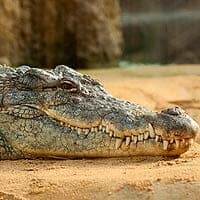
Nile crocodile (Crocodylus niloticus)
Animalia Crocodilia Crocodylidae Crocodylus Crocodylus niloticus The Nile Crocodile is the most popular crocodile species in the world. Primarily freshwater habitats in Africa and sub-Saharan Africa prefer to live in several aquatic environments, including brackish lakes, delta rivers, swamps, and marshlands. This largest freshwater predator of Africa is considered the second-largest extant reptile after the saltwater crocodile.
Like other crocodiles listed above, these opportunistic ambush predators are very aggressive and have a powerful bite with conical teeth. Nile crocodiles can take down almost anything within their territories, including fish species, reptiles, birds, and mammals.An Austrian naturalist, Josephus Nicolaus Laurenti, named this crocodile species into the Crocodilia order in 1768.
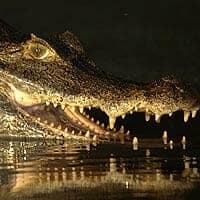
Orinoco Crocodile (Crocodylus intermedius)
Animalia Crocodilia Crocodylidae Crocodylus Crocodylus intermedius The Orinoco crocodiles can be found only in freshwater regions, particularly in Colombia and Venezuela around the Orinoco River and its surroundings. These are critically endangered crocodiles due to extensive hunting for their skins in the last 200 years. Orinoco crocodiles are primarily piscivorous (i.e., fish-eater), but they can also prey on other reptiles, birds, mammals, or even other caimans. These dig holes on the ground to lay their eggs, similar to the Nile or other saltwater crocodiles.
In 1819, Graves classified has added this crocodile species into the taxonomy.
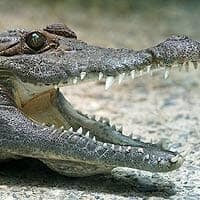
Philippine Crocodile (Crocodylus mindorensis)
Animalia Crocodilia Crocodylidae Crocodylus Crocodylus mindorensis The Philippine crocodile is also called Mindoro crocodile, the Philippine freshwater crocodile, bukarot, or buwaya. Endemic to the Philippines, it is one of the two Filipino crocodiles. Critically endangered due to over-exploitation and unsustainable fishing methods, these golden-brown freshwater bukarots are conserved by the Mabuwaya foundation.
Karl Patterson Schmidt, an American herpetologist, added the Philippine crocodile to the binomial classification as a valid crocodile species in 1935.
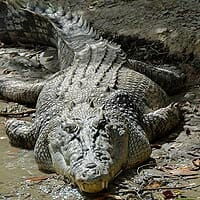
Saltwater Crocodile (Crocodylus porosus)
Animalia Crocodilia Crocodylidae Crocodylus Crocodylus porosus The saltwater crocodiles are saltwater habitats widely distributed in many parts of the world, including India’s east coast, the northern part of Australia, Sundaic regions, and Micronesia. Although IUCN listed this crocodile as Least Concern (LC), it is threatened by illegal hunting for its skins. The saltwater crocodiles are the giant living reptiles globally, growing up to 21 feet and weighing around 2900 lbs. The other names of this opportunistic and hyper-carnivorous ambush predator are estuarine crocodile, Indo-Pacific crocodile, marine crocodile, sea crocodile, or saltie. They can take down even sharks once it’s on their territories and preys on pelagic species, fish species, crustaceans, reptiles, birds, mammals even humans.
Johann Gottlob Theaenus Schneider, a German naturalist, added the Saltwater crocodile into binomial classification in 1801.
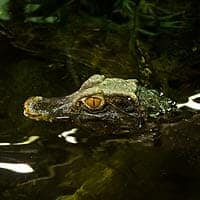
Schneider's Dwarf Caiman (Paleosuchus trigonatus)
Animalia Crocodilia Alligatoridae Paleosuchus Paleosuchus trigonatus The Schneider’s dwarf caiman or Schneider’s smooth-fronted caiman is the crocodile species from the Amazon and Orinoco basins of South America. This freshwater croc is the second-smallest alligator (grows up to 5.2 ft) after Cuvier’s dwarf caiman. They feed on pacas, porcupines, snakes, birds, lizards, fish, and mollusks. Interestingly, the smooth-fronted caiman is not widely hunted as its skin contains many bony scutes, making it challenging to make leather goods from them. As a result, IUCN status is Least Concern (LC).
Another discovery by Johann Gottlob Theaenus Schneider, a German naturalist, named this dwarf crocodile after his surname in 1801.
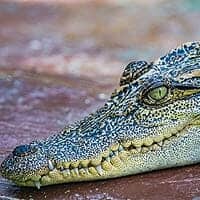
Siamese Crocodile (Crocodylus siamensis)
Animalia Crocodilia Crocodylidae Crocodylus Crocodylus siamensis The Siamese Crocodile is another medium-sized freshwater endemic to Asian countries, including Indonesia, Brunei, Malaysia, Laos, Cambodia, Myanmar, Thailand, and Vietnam. The other nicknames are Siamese freshwater crocodile, Singapore small-grain, and soft-belly. Siamese crocs prey mainly on fish, snakes, amphibians, and small mammals.
A German naturalist, Johann Gottlob Theaenus Schneider, had added the Siamese crocodile into the taxonomy in 1801.
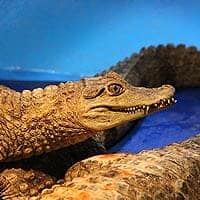
Spectacled Caiman (Caiman crocodilus)
Animalia Crocodilia Alligatoridae Caiman Caiman crocodilus The Spectacled Caiman got its name from a spectacle-like ridge between its eyes. The other names are the white caiman, common caiman, and speckled caiman. These freshwater brownish and greenish crocodiles’ diet varies from season to season ranging from crabs, fish, mammals, and snails.
This Spectacled Caiman species is native to Latin America.In 1758, Carl Linnaeus, a famous Swedish zoologist, added the Spectacled caiman into the binomial classification as a valid crocodile species.
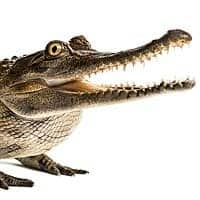
West African Slender-snouted Crocodile (Mecistops cataphractus)
Animalia Crocodilia Crocodylidae Mecistops Mecistops cataphractus The West African slender-snouted crocodile is one of 5 crocodile species of Africa. The West African slender-snouted crocodile is medium-sized with a very long, slender snout used to catch fish. They prefer to habitat in dense, vegetated bodies of freshwater. Currently, IUCN has given the status of Critically Endangered due to the declining population.
Georges Cuvier, a French naturalist, named the West African slender-snouted crocodile species into taxonomy in 1825.
Types of Crocodiles by Waterbodies
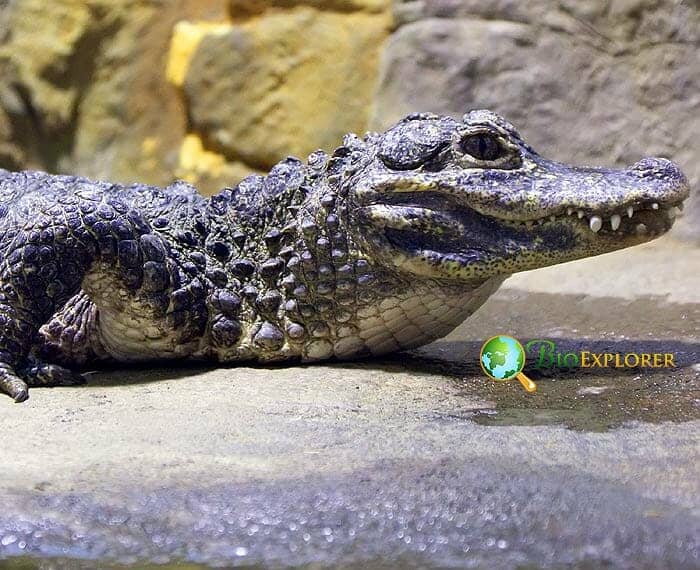
| American Alligator | Alligator mississippiensis | Freshwater |
| American Crocodile | Crocodylus acutus | Saltwater |
| Australian Freshwater crocodile | Crocodylus johnsoni | Freshwater |
| Black Caiman | Melanosuchus niger | Freshwater |
| Broad-snouted Caiman | Caiman latirostris | Freshwater |
| Chinese Alligator | Alligator sinensis | Freshwater |
| Cuban crocodile | Crocodylus rhombifer | Freshwater |
| Cuvier’s dwarf caiman | Paleosuchus palpebrosus | Freshwater |
| Dwarf crocodile | Osteolaemus tetraspis | Freshwater |
| False gharial | Tomistoma schlegelii | Freshwater |
| Gharial | Gavialis gangeticus | Freshwater |
| Jacare Caiman | Caiman yacare | Freshwater |
| Morelet’s crocodile | Crocodylus moreletii | Freshwater |
| Mugger crocodile | Crocodylus palustris | Freshwater |
| New Guinea crocodile | Crocodylus novaeguineae | Freshwater |
| Nile crocodile | Crocodylus niloticus | Freshwater |
| Orinoco crocodile | Crocodylus intermedius | Freshwater |
| Philippine crocodile | Crocodylus mindorensis | Freshwater |
| Saltwater crocodile | Crocodylus porosus | Saltwater |
| Schneider’s dwarf caiman | Paleosuchus trigonatus | Freshwater |
| Siamese crocodile | Crocodylus siamensis | Freshwater |
| Spectacled Caiman | Caiman crocodilus | Freshwater |
| West African slender-snouted crocodile | Mecistops cataphractus | Freshwater |
![]()
Crocodiles by Year of Taxonomy Classification
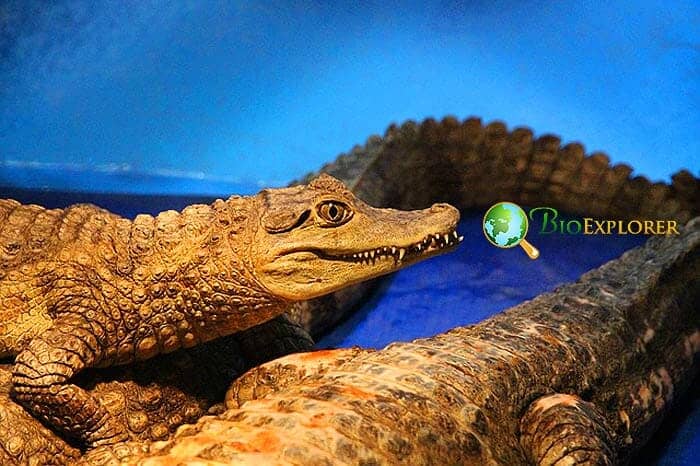
From a taxonomy classification perspective, spectacled-caiman was the first crocodile species to be added to the Crocodilia order by Carl Linnaeus in 1758. The last crocodile species to be added was the Philippine Crocodile by Karl Patterson Schmidt in 1935.
| Spectacled Caiman | Caiman crocodilus | 1758 | Carl Linnaeus | Swedish Zoologist |
| Nile crocodile | Crocodylus niloticus | 1768 | Josephus Nicolaus Laurenti | Austrian Naturalist |
| Gharial | Gavialis gangeticus | 1789 | Johann Friedrich Gmelin | German Naturalist |
| Saltwater crocodile | Crocodylus porosus | 1801 | Johann Gottlob Theaenus Schneider | German Naturalist |
| Schneider’s dwarf caiman | Paleosuchus trigonatus | 1801 | Johann Gottlob Theaenus Schneider | German Naturalist |
| Siamese crocodile | Crocodylus siamensis | 1801 | Johann Gottlob Theaenus Schneider | German Naturalist |
| American Alligator | Alligator mississippiensis | 1802 | Franççois Marie Daudin | French Zoologist |
| Broad-snouted Caiman | Caiman latirostris | 1802 | Franççois Marie Daudin | French Zoologist |
| Jacare Caiman | Caiman yacare | 1802 | Franççois Marie Daudin | French Zoologist |
| American Crocodile | Crocodylus acutus | 1807 | Georges Cuvier | French Naturalist |
| Cuban crocodile | Crocodylus rhombifer | 1807 | Georges Cuvier | French Naturalist |
| Cuvier’s dwarf caiman | Paleosuchus palpebrosus | 1807 | Georges Cuvier | French Naturalist |
| Orinoco crocodile | Crocodylus intermedius | 1819 | Graves | n/a |
| Black Caiman | Melanosuchus niger | 1825 | Johann Baptist von Spix | German Biologist |
| West African slender-snouted crocodile | Mecistops cataphractus | 1825 | Georges Cuvier | French Naturalist |
| Mugger crocodile | Crocodylus palustris | 1831 | Renéé Lesson | French Herpetologist |
| False gharial | Tomistoma schlegelii | 1838 | Salomon Müüller | German Naturalist |
| Morelet’s crocodile | Crocodylus moreletii | 1851 | Gabriel Bibron & Andréé Marie Constant Dumééril | French Zoologists |
| Dwarf crocodile | Osteolaemus tetraspis | 1861 | Edward Drinker Cope | American Herpetologist |
| Australian Freshwater crocodile | Crocodylus johnsoni | 1873 | Gerard Krefft | Australian Zoologist |
| Chinese Alligator | Alligator sinensis | 1879 | Albert-Auguste Fauvel | French Naturalist |
| New Guinea crocodile | Crocodylus novaeguineae | 1928 | Karl Patterson Schmidt | American Herpetologist |
| Philippine crocodile | Crocodylus mindorensis | 1935 | Karl Patterson Schmidt | American Herpetologist |
![]()
Crocodiles Distribution By Countries/Regions
| Nile crocodile | Crocodylus niloticus | Africa |
| American Crocodile | Crocodylus acutus | Americas |
| Cuvier’s dwarf caiman | Paleosuchus palpebrosus | Americas |
| Saltwater crocodile | Crocodylus porosus | Asia |
| Siamese crocodile | Crocodylus siamensis | Asia |
| Australian Freshwater crocodile | Crocodylus johnsoni | Australia |
| Chinese Alligator | Alligator sinensis | China |
| Cuban crocodile | Crocodylus rhombifer | Cuba |
| Gharial | Gavialis gangeticus | Indian Subcontintent |
| Mugger crocodile | Crocodylus palustris | Indian Subcontintent |
| Spectacled Caiman | Caiman crocodilus | Latin America |
| Morelet’s crocodile | Crocodylus moreletii | Mexico, Belize, Guatemala |
| New Guinea crocodile | Crocodylus novaeguineae | New Guinea |
| False gharial | Tomistoma schlegelii | Peninsular Malaysia |
| Philippine crocodile | Crocodylus mindorensis | Philippines |
| Schneider’s dwarf caiman | Paleosuchus trigonatus | South America |
| Broad-snouted Caiman | Caiman latirostris | South America |
| Jacare Caiman | Caiman yacare | South America |
| Orinoco crocodile | Crocodylus intermedius | South America |
| Black Caiman | Melanosuchus niger | South America |
| American Alligator | Alligator mississippiensis | USA |
| West African slender-snouted crocodile | Mecistops cataphractus | West Africa |
| Dwarf crocodile | Osteolaemus tetraspis | West Africa |
![]()


